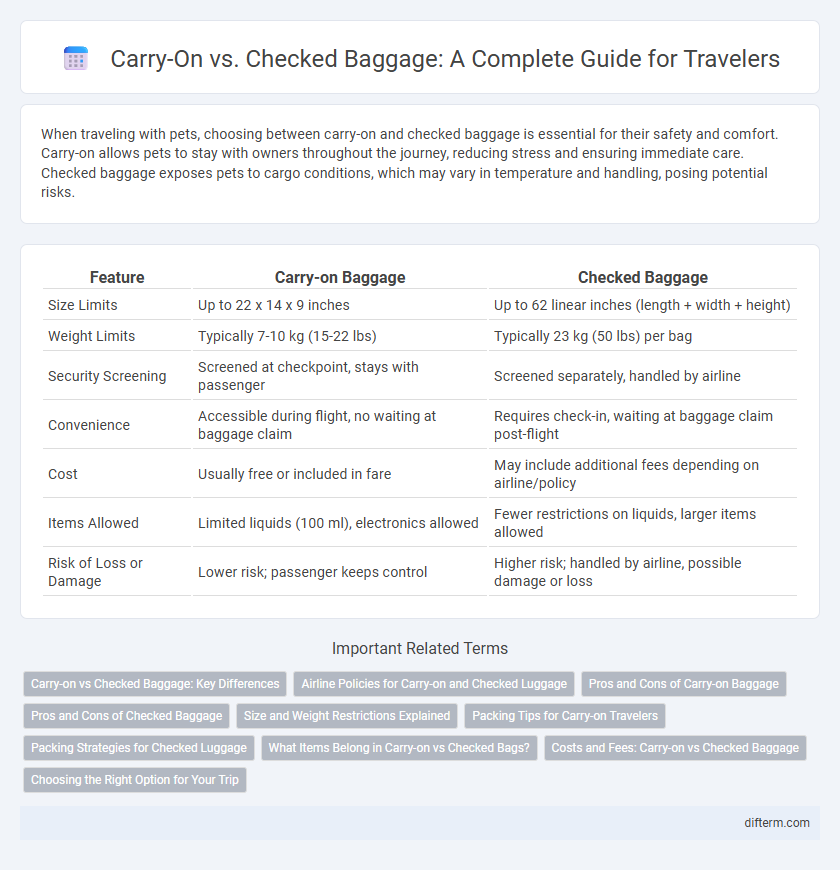When traveling with pets, choosing between carry-on and checked baggage is essential for their safety and comfort. Carry-on allows pets to stay with owners throughout the journey, reducing stress and ensuring immediate care. Checked baggage exposes pets to cargo conditions, which may vary in temperature and handling, posing potential risks.
Table of Comparison
| Feature | Carry-on Baggage | Checked Baggage |
|---|---|---|
| Size Limits | Up to 22 x 14 x 9 inches | Up to 62 linear inches (length + width + height) |
| Weight Limits | Typically 7-10 kg (15-22 lbs) | Typically 23 kg (50 lbs) per bag |
| Security Screening | Screened at checkpoint, stays with passenger | Screened separately, handled by airline |
| Convenience | Accessible during flight, no waiting at baggage claim | Requires check-in, waiting at baggage claim post-flight |
| Cost | Usually free or included in fare | May include additional fees depending on airline/policy |
| Items Allowed | Limited liquids (100 ml), electronics allowed | Fewer restrictions on liquids, larger items allowed |
| Risk of Loss or Damage | Lower risk; passenger keeps control | Higher risk; handled by airline, possible damage or loss |
Carry-on vs Checked Baggage: Key Differences
Carry-on baggage offers the advantage of quick access and eliminates the risk of lost luggage, typically restricted to dimensions around 22 x 14 x 9 inches and a weight limit of 7-10 kg depending on the airline. Checked baggage allows for larger, heavier items with typical allowances ranging from 20 to 50 pounds per bag and size up to 62 linear inches but involves longer wait times and potential fees. Travelers must balance convenience and packing needs, considering airline policies, fees, and security regulations when choosing between carry-on and checked baggage.
Airline Policies for Carry-on and Checked Luggage
Airline policies for carry-on and checked baggage vary significantly, with most carriers allowing one carry-on bag and one personal item free of charge, typically limited to dimensions around 22 x 14 x 9 inches and a weight of 7-10 kg. Checked baggage policies often include fees, with weight limits commonly ranging from 23 kg (50 lbs) for economy class to 32 kg (70 lbs) for premium cabins, and size restrictions usually maxing out at 62 linear inches (length + width + height). Understanding specific airline regulations on size, weight, prohibited items, and fees for both carry-on and checked luggage helps travelers avoid surprises and ensures smoother airport experiences.
Pros and Cons of Carry-on Baggage
Carry-on baggage offers the advantage of faster airport navigation by eliminating the wait at baggage claim and reducing the risk of lost luggage. Airlines often impose strict size and weight limits on carry-ons, potentially limiting the amount of items travelers can bring. While carry-ons provide convenience and cost savings by avoiding checked baggage fees, they may require strategic packing to optimize space and comply with airline regulations.
Pros and Cons of Checked Baggage
Checked baggage offers the convenience of transporting larger and heavier items without the restrictions imposed on carry-on luggage, making it ideal for extended trips or those requiring multiple outfits and equipment. However, it comes with the risk of lost or delayed bags, potential additional fees from airlines, and longer wait times at baggage claim, which can add stress to the travel experience. Security procedures for checked bags are generally more stringent, and passengers must ensure compliance with airline weight limits to avoid costly surcharges.
Size and Weight Restrictions Explained
Carry-on baggage typically adheres to size limits of around 22 x 14 x 9 inches and weight restrictions varying between 7 to 15 pounds depending on the airline, ensuring it fits in overhead bins. Checked baggage allowances generally permit larger dimensions up to 62 linear inches (length + width + height) and heavier weights, commonly capped at 50 pounds, with fees applied for overweight items. Understanding these size and weight restrictions helps travelers avoid additional charges and streamline the airport experience.
Packing Tips for Carry-on Travelers
Maximize space in your carry-on by rolling clothes to minimize wrinkles and using packing cubes to organize items efficiently. Limit liquids to TSA-approved containers of 3.4 ounces or less, stored in a clear, quart-sized bag for smooth security checks. Prioritize essential items like chargers, medications, and a change of clothes in easily accessible compartments to stay prepared during travel delays.
Packing Strategies for Checked Luggage
Maximizing space in checked luggage involves rolling clothes tightly and using compression bags to reduce volume. Placing heavier items at the bottom near the wheels enhances balance and prevents crushing delicate belongings. Organizing with packing cubes streamlines access and keeps similar items together, improving efficiency during your trip.
What Items Belong in Carry-on vs Checked Bags?
Essential items such as passports, medications, electronics, and valuables belong in carry-on bags to ensure accessibility and security during travel. Bulky clothing, toiletries exceeding airline liquid limits, and non-essential or fragile items are better suited for checked baggage to comply with airline regulations and reduce carry-on weight. Understanding these distinctions helps travelers avoid delays and enhances overall travel convenience.
Costs and Fees: Carry-on vs Checked Baggage
Carry-on baggage typically incurs no extra fees, making it a cost-effective choice for travelers seeking to avoid additional expenses. Checked baggage often requires payment, with airline fees varying from $25 to $60 per bag depending on the carrier and route. Budget airlines frequently charge higher fees for checked bags, emphasizing the importance of weighing savings from carry-on luggage against the convenience of checked baggage for longer trips.
Choosing the Right Option for Your Trip
Choosing between carry-on and checked baggage depends on travel duration, airline policies, and personal convenience. Carry-on bags offer quicker airport navigation and reduce the risk of lost luggage, while checked baggage allows for more packing space and less physical burden during transit. Assess factors like trip length, packing needs, and security procedures to select the most efficient option for stress-free travel.
Carry-on vs Checked baggage Infographic

 difterm.com
difterm.com